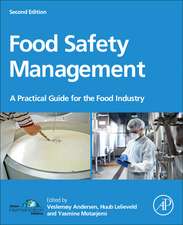Ensuring Global Food Safety: Exploring Global Harmonization
Editat de Aleksandra Martinovic, Sangsuk Oh, Huub Lelievelden Limba Engleză Paperback – 14 feb 2022
This book illuminates these issues, offering guidelines for moving toward a scientifically sound approach to food safety regulation that can also improve food security without putting consumers at risk.
- Presents the progress and current status of regulatory harmonization for food standards
- Provides a science-based foundation for global regulatory consensus
- Approaches challenges from a risk-benefit approach, also including safety assurance
- Includes global perspectives from governmental, academic and industry experts
Preț: 685.69 lei
Preț vechi: 887.32 lei
-23% Nou
Puncte Express: 1029
Preț estimativ în valută:
131.24€ • 136.50$ • 109.98£
131.24€ • 136.50$ • 109.98£
Carte tipărită la comandă
Livrare economică 06-20 martie
Preluare comenzi: 021 569.72.76
Specificații
ISBN-13: 9780128160114
ISBN-10: 012816011X
Pagini: 560
Dimensiuni: 216 x 276 x 32 mm
Greutate: 1.28 kg
Ediția:2
Editura: ELSEVIER SCIENCE
ISBN-10: 012816011X
Pagini: 560
Dimensiuni: 216 x 276 x 32 mm
Greutate: 1.28 kg
Ediția:2
Editura: ELSEVIER SCIENCE
Public țintă
Governmental policy-makers, researchers and academics addressing the concerns of food insecurity around the world ; lawyers, legal departments of multinational companies, companies that export and import food; food quality and safety laboratoriesCuprins
1. Introduction - Ensuring Global Food Safety: A Public Health Priority and a Global Responsibility
2. Safety and Security: The Cost of Food Regulatory Failure
3. Development of Food Legislation Around the World
4. Integrated Risk Assessment and Cost Benefit Analysis: An Economics Perspective on International Trade and Food Safety
5. The Global Harmonization Initiative
6. Food Safety Regulations within Countries of Increasing Global Supplier Impact
7. A Simplified Guide to Understanding and Using Food Safety Objectives and Performance Objectives
8. Regulating emerging food trends: A Case Study in Insects as Food for Humans
9. Towards Intended Normal Use: A European Appraisal of the Chloramphenicol Case and some Thoughts on the Potential of Global Harmonization of Antibiotics Regulation
10. RDAs and Intended Normal Use – Efficient Tools in the Universal Management of Risks and Benefits of Micronutrients
11. Global Harmonization of Food Regulations: Benefits and Risks of Organic Food
12. Mycotoxin Management: An International Challenge
13. Novel Food Processing Technologies and Regulatory Hurdles
14. Processing Issues: Acrylamide, Furan and Trans Fatty Acids
15. Food additives and Other Substances Added to Human Food
16. Food Packaging Legislation: Sanitary Aspects
17. Nanotechnology and Food Safety
18. Monosodium Glutamate in Foods and its Biological Effects
19. Responding to Incidents of Low-Level Chemical Contamination in Food
20. Nutraceuticals: Possible Future Ingredients and Food Safety Aspects
21. Nutrition and Bioavailability: Sense and Nonsense of Nutrition Labelling
22. Regulating Nutrition Claims: A Case Study: The First Legislation for Foods with Health Claims in Korea
23. Bioactivity, Benefits and Safety of Traditional and Ethnic Foods
24. Water Determination in Food
25. Global Harmonization of Analytical Methods
26. Global Harmonization of the Control of Microbiological Risks
27. Testing for Food Safety Using Competent Human Liver Cells
28. Harmonization of International Standards
29. Capacity Building: Harmonization and Achieving Food Safety
30. Capacity Building: Building Analytical Capacity for Microbial Food Safety
31. Education in food safety at all levels, from academics to street handlers
2. Safety and Security: The Cost of Food Regulatory Failure
3. Development of Food Legislation Around the World
4. Integrated Risk Assessment and Cost Benefit Analysis: An Economics Perspective on International Trade and Food Safety
5. The Global Harmonization Initiative
6. Food Safety Regulations within Countries of Increasing Global Supplier Impact
7. A Simplified Guide to Understanding and Using Food Safety Objectives and Performance Objectives
8. Regulating emerging food trends: A Case Study in Insects as Food for Humans
9. Towards Intended Normal Use: A European Appraisal of the Chloramphenicol Case and some Thoughts on the Potential of Global Harmonization of Antibiotics Regulation
10. RDAs and Intended Normal Use – Efficient Tools in the Universal Management of Risks and Benefits of Micronutrients
11. Global Harmonization of Food Regulations: Benefits and Risks of Organic Food
12. Mycotoxin Management: An International Challenge
13. Novel Food Processing Technologies and Regulatory Hurdles
14. Processing Issues: Acrylamide, Furan and Trans Fatty Acids
15. Food additives and Other Substances Added to Human Food
16. Food Packaging Legislation: Sanitary Aspects
17. Nanotechnology and Food Safety
18. Monosodium Glutamate in Foods and its Biological Effects
19. Responding to Incidents of Low-Level Chemical Contamination in Food
20. Nutraceuticals: Possible Future Ingredients and Food Safety Aspects
21. Nutrition and Bioavailability: Sense and Nonsense of Nutrition Labelling
22. Regulating Nutrition Claims: A Case Study: The First Legislation for Foods with Health Claims in Korea
23. Bioactivity, Benefits and Safety of Traditional and Ethnic Foods
24. Water Determination in Food
25. Global Harmonization of Analytical Methods
26. Global Harmonization of the Control of Microbiological Risks
27. Testing for Food Safety Using Competent Human Liver Cells
28. Harmonization of International Standards
29. Capacity Building: Harmonization and Achieving Food Safety
30. Capacity Building: Building Analytical Capacity for Microbial Food Safety
31. Education in food safety at all levels, from academics to street handlers






















